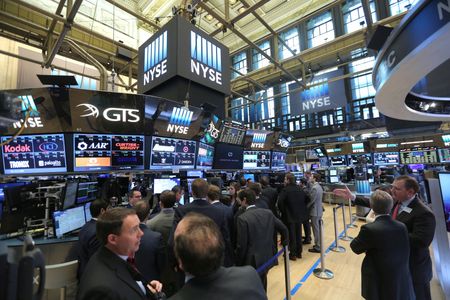By Jamie McGeever
ORLANDO, Florida (Reuters) -If you want evidence of how much the ‘soft landing’ narrative is driving bullish investor sentiment, look no further than benchmark measures of implied volatility.
In equities, bonds, credit and currencies, ‘vol’ has not been this low in years, clearing the way for investors to push up asset prices to historic and, in the case of the S&P 500 and Nasdaq, record highs.
The broad calculation is the Federal Reserve will steer U.S. inflation down toward its 2% target then start cutting interest rates to ensure the slowing economy avoids recession. Other central banks will follow a similar playbook.
The obvious question is: are investors getting too complacent, and if so, are markets setting themselves up for a bruising fall? Or worse?
Unfortunately, there’s no clear answer. U.S. equity, bond and credit markets have enjoyed years of subdued vol before a major correction or crash. Admittedly, these spells were often when interest rates were near zero and the Fed was conducting trillions of dollars of quantitative easing.
Equally, that serenity can be blown away in an instant and markets can get ugly very quickly – witness ‘Volmageddon’ in February 2018, the U.S. banking system liquidity scare later that year, or the pandemic in March 2020.
The ultra-low vol is “complacency if you believe this is the calm before the storm, and that the economic story isn’t that strong,” says Mandy Xu, head of derivatives market intelligence at Cboe Global Markets.
Investors may be starting to hedge against the tide turning, via options. So far this year VIX options volume is on course for a record average daily volume of 785,000 contracts a day, compared to 743,000 in 2023 and 533,000 in 2022, Xu notes.
BEAR IN MIND
Some may choose to hedge the risk of a market reversal by holding cash – some $6 trillion is in money market funds earning over 5% a year – or riding gold’s wave to record highs.
What’s clear right now, on the surface at least, is markets could not be calmer.
U.S. investment grade credit vol is the lowest since the Cboe back-tested its VIXIG index to 2012, the VIX index of implied vol in the S&P 500 just had its lowest close since 2019, and the MOVE index of implied vol in U.S. Treasuries is the lowest since February 2022, just before the Fed embarked on its 500-basis point rate-hiking cycle.
Analysts at JP Morgan are among those viewing the landscape with growing unease, citing “optically thin” credit spreads, “very high” equity valuations and low volatility as reasons to be cautious.
“We do not see equities as attractive investments at the moment,” prominent bear Marko Kolanovic and his U.S. equity strategy team wrote this week. “With risk markets pricing in very little probability of deviation from soft landing, we believe that a defensive stance is justified.”
The reward for buying stocks now may be good enough “in an environment where nothing is breaking”, they say. Given how well stocks have performed, especially in the face of a much more hawkish Fed outlook this year, Kolanovic’s stance is a bold one.
Alternatively, he should be commended for sticking to his guns unlike Morgan Stanley’s Mike Wilson, the other big bear on Wall Street. He just revised up his S&P 500 forecast by 20% – a contrarian sign that the market top is in?
When volatility does start to stir, the catalyst is likely to be in the interest rate space, specifically a shift in the Fed policy outlook and potential divergence with other central banks.
RECORD LOW EUR/GBP VOL
Currency analysts at Deutsche Bank, Morgan Stanley and Bank of America have this week all questioned how long the relatively close convergence of policy outlooks across major central banks will last.
Closer policy alignment limits interest rate divergence at the short end of the curve and depresses volatility. This creates a conundrum for traders who seek to profit from locking in wide rate differentials between currencies in so-called carry trades.
“Markets cannot have it both ways: carry and high volatility are mutually exclusive and investors must accept that for now, carry is effectively a passive strategy and a vol dampener,” BofA analysts wrote on Monday.
Their counterparts at Morgan Stanley expect policy divergence to re-emerge in the second half of the year, making for potentially more turbulent waters as the pace of cuts and terminal rates are “likely to vary widely,” particularly between the United States and the rest of the world.
Developments in Britain on Wednesday offered an insight into how this can play out. Figures showed inflation didn’t fall last month quite as much as investors had expected, then hours later prime minister Rishi Sunak called a general election for July 4.
Two-month implied vol in euro/sterling spiked the most in over a year, a notable move but from a low base. Remarkably, two-month euro/sterling vol had never been lower since the euro was launched in 1999.
(The opinions expressed here are those of the author, a columnist for Reuters.)
(By Jamie McGeever; Editing by Toby Chopra)





